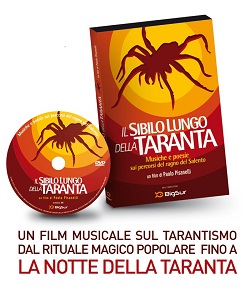
|
||||||||||||||||||||||||||||||||||||||||||||||||
|
||||||||||||||||||||||||||||||||||||||||||||||||
|
|
The hiss of the spider
Il Sibilo Lungo della Taranta, 2005. Documentary Film by Paolo Pisanelli. Reviewed by Dominic Ambrose.
It is said that the tarantella originated as a cure for people affected by the bite of the tarantula. Now this historical form, the taranta pizzica (the bite dance) is the subject of Paolo Pisanelli's documentary, Il Sibilo Lungo della Taranta (the long hiss of the spider). Pisanelli goes to the heart of tarantella culture, to Puglia, and looks at the phenomenon in the area of the Salento, the extreme southernmost part of the heel of the Italian boot. The bite of the local tarantula is not merely a physical event, but a psychic eruption, a mystery wrapped in legend, a secret of the soul. It is not so important if these spiders really did bite women in the past (and then mysteriously stopped), what is far more significant is what role these bites and their ritual cleansings had in the society of Southern Italy. The film begins by investigating the history of tarantism, using film from a 1960s documentary. It explores the cultural legacy that tarantism has left for today's inhabitants. In the old film we see women writhing and gyrating wildly in their humble homes, as village musicians played music and sang. These ritual healings would often last through an entire night and end with the affected women making a pilgrimage to the church of St. Paul "of the Spiders" in Melpignano. The words of the anthropologist Ernesto De Martino are used to explain the psychological power of these rituals to cleanse women of the effects of an oppressive social structure. This fascinating historical study is progressively intercut with images of the people of the region today, who infect the film with their healthy optimism about life in this arid and poor region of Italy. At the same time, the film is moved forward by the prospect of a popular music festival to be held in the town of Melpignano, celebrating the traditions of Pizzica (bite) music. Eventually, the theme of the upcoming music festival takes over. We see the preparations, the auditions, the instructions given by Maestro Ambrogio Sparagno to the performers, who will become part of a new ensemble, the Orchestra Popolare La Notte della Taranta. We see the townspeople getting excited in spite of themselves about the arrival of 50, 60 or 70, 000 people for this all night musical feast in August. The mayor of the town gives an interview in which he talks about the significance of the preservation of traditional culture for this region, which has been drained by emigration for over a century. For him and for many others, the concert has become a symbol of a healing of this open wound in the rural society. That it is also an economic shot in the arm for this isolated province is not bad, either. The auditions are wonderful to watch, the clear, brilliant voices of the singers, mostly women, who show up to sing the age old melismatic, entrancing sounds of pizzica, add a glorious new dimension to the story. The beauty of their dark Mediterranean faces, the grace of their movements and the quicksilver flow of their singing is magical. Finally, the night of the concert arrives, "La Notte della Taranta." Tens of thousands of people have materialized, mostly young people who are filled with enthusiasm, dancing on the grass at the outdoor concert, and jumping up and down in a sea of tarantism. The elderly townspeople, who had been seen earlier in the film debating dubiously about the coming festival, are shown watching on their huge living room TVs. At first they sit skeptically on the edge of their upholstery, then they begin to clap softly, then eventually rising to their feet to dance around the room with the uncontainable joy of seeing their lifelong culture finally justified by the television cameras. For a people who have lived their culture for decades laboring under obscurity and prejudice, it is liberating moment. Il Sibilo Lungo della Taranta is a multilayered and complex documentary that brings to life a world that is significant as a repository of ancient culture and knowledge which has been almost forgotten in our mad rush toward modernity. It is a joy to watch for any lovers of Mediterranean culture, and especially for those interested in the culture of Magna Grecia, the lands of Southern Italy that were a major part of the Greek civilization before the rise of Rome. These are the lands where the synthesis of Greek and Roman culture first came about, forming the basis for our Western world. For those of us who are the children of the great Southern Italian diaspora in Europe and the Americas, it can also have another great significance, as an opportunity to see how our ancestral lands can continue to develop and be relevant to our lives. We have forgotten too much because our grandparents spoke with a voice that we could never understand. Finally we have an opportunity to hear them speak with the voices of our contemporaries and it is a glorious revelation. The Documentary is a production of Big Sur in collaboration with local entities of the Province of Lecce. Paolo Pisanelli is a filmmaker with several well received documentaries to his credit, including films about Don Vitaliano, the activist priest, and another about Enrico Berlinguer, the late leader of the PCI. Music & dances | Taranta & pizzica dance | Pizzicarella | Viddhaneddha Calabria dance | Laments work & love songs | The women of the south | The secular music of the south |
Dominic Ambrose is a writer and script developer living in Paris. |

|
||||||||||||||||||||||||||||||||||||||||||||||
|
||||||||||||||||||||||||||||||||||||||||||||||||

